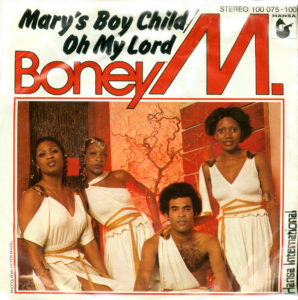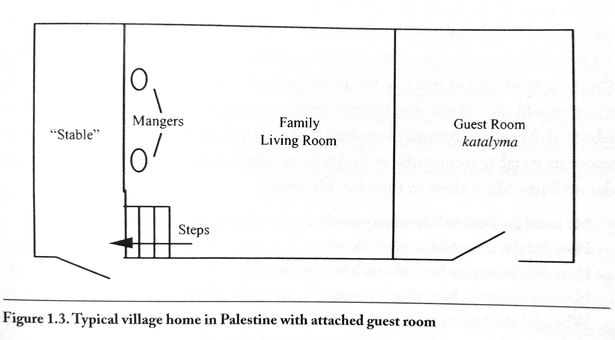This article is largely inspired by the article The Christmas Story’s Surprising Call for Community, published in Relevant Magazine in early December 2016. We will explore various aspects to the Christmas Story and the birth of Jesus and how a lot of what we may be singing via Christmas Carols or songs may actually be a misinformation and less accurate depiction of the true, cultural context for the original Christmas setting.
Inn & Manger Settling: Lonely or Community?

Mary’s boy child Jesus Christ, was born on Christmas Day
And man will live for evermore, because of Christmas Day
These two lines should be instantly recognisable as the chorus of the Christmas song Mary’s Boy Child, made famous by the rendition performed and released by Boney M in 1978. As we progress further and deeper into the song, we sing the following words in the third verse:
And then they found a little nook in a stable all forlorn
And in a manger cold and dark, Mary’s little boy was born
This is typical of the imagery and understanding we tend to form nowadays, particularly in cultures like Australia/US/UK, of how the general Christmas story plays out. The settling of Jesus’ birth was humble and simple, in a manger away from the main community and village that was and is Bethlehem. In some traditions, it is recorded that the setting is a cave instead of an actual building.
In the Gospel of Luke, he mentioned specifically that there was “no room in the inn”. However, Luke used two different words to mean “inn”: katalyma and pandocheion. Katalyma means “a guest room that was part of someone’s home” and we can verify this because Luke reuses it in the context of the disciples finding an appropriate katalyma for the events of the Last Supper. In contrast, pandocheion means “commercial accommodation”. This distinction is further adhered to in the NIV translation:
Because there was no guest room available for them
In a typical Palestinian home, the guest room was adjacent to the main family living quarters. Further, in this typical layout, the manger for the animals is located at one end of the main family home/room.

Even if there were an inn in Bethlehem, Joseph and Mary would not have been staying there because the reason for their travel to Bethlehem was the census AND because Joseph had family there. The customs of first-century Palestine would have required him to stay with relatives and not with strangers.
Given these facts, the katalyma where he stayed would not have been an inn, but a guest room in the house of the family where Joseph and Mary were staying. That could very well have been full with other relatives who had arrived before them. This is arguably the most significant theological difference in our general understanding of the Gospels versus popular culture today because there is a tendency to suggest that Jesus’ birth was in the setting of separation from the main community; that his parents were shunned and the baby Lord Jesus came into this world surrounded by animals.
Instead, a more accurate understanding is that Jesus was born surrounded by extended family all who claimed lineage to the house of David, and in a more communal setting.
Animals
In the Christmas Carol Away in a Manger, imagery of lowing cattle is evoked, and a lot of traditional nativity scenes include the full gamut of animals. Since the advent of the Christmas nativity scene in the 1223 by St Francis of Assisi, a core component has always been to incorporate animals – specifically the donkey and ox because of the biblical reference to Isaiah 1:3:
The ox knoweth his owner, and the ass his master’s crib; but Israel doth not know, my people doth not consider.
Further, when we read the bible verses recorded in the Gospels, technically there is no mention of what animals were present at the birth, other than the fact that a manger, as feed trough for the animals implies the presence of animals.
Given the context established above, for the family home setting, only household animals would be brought in, and only at night-time as a form of protection for the animals. Since the birth took place NOT in a stable, the presence of animals is limited.
Naturally, a lot of the nativity scenes simplify the sequence of events into the one and the presence of sheep is easily understood given the narrative does talk about sheep. However, the Gospel according to Luke (Luke 2) never mentions the shepherds bringing their sheep with them, which we should be able to appreciate as logistically challenging. Whilst it is clear and explicit that the shepherds themselves go to see for themselves the miracle that the angels sang and proclaimed, the likelihood that they brought their sheep with them is stretching the truth a little.
We Three Kings of Orient…
As the carol lyrics go:
We three kings of Orient are
Bearing gifts we traverse afar.
Field and fountain, moor and mountain,
Following yonder star.
This topic has been widely discussed over many years. The number three is a traditional belief and some will argue makes sense since the magi provide to Jesus three different gifts – gold, frankincense and myrrh. Again, the simplicity for minimising the number to three magi enables a nativity scene to ensure each magi/wise man brings one different gift each. The Bible says only that “magi from the east” followed a strange star to visit the infant child. The word “magi” or “wisemen” originally referred to a class of priests, probably from Persia. As students of astrology, they were the most likely audience to notice a galactic anomaly to begin with. If Jesus’ visitors had been royalty, the Gospel writers would likely have included such a detail. Instead, Renaissance art depicted king-like figures at Jesus’ birth and this has no doubt helped to reinforce the misrepresentation of the nature of the “magi”.
Christian tradition even name these “three kings”: Melchior, Gaspar, and Balthasar, but all of this is simply made up and guessed. The endurance of the three kings throughout history may stem, again, from its poignancy. The sight of earthly kings bowing to the infant “king of the universe” is a memorable, if one that may not actually be historically true.
Safe Carols?
So, are there safe carols which we can sing and not worry about the lyrics being biblically accurate? Absolutely! My favourite carol mentions the wise men from Orient far, but wisely avoids being explicit about how many there are. The very next line then references the “lowly manger”, but I believe there is room to interpret this as the manger itself is lowly, and the location of the lowly manger is not itself lowly. Check out the full lyrics reproduced here of one of my absolute favourite Christmas Carols – O Holy Night:
Verse 1
O holy night!
The stars are brightly shining
It is the night of the dear Savior’s birth!
Long lay the world in sin and error pining
Till he appear’d and the soul felt its worth.
A thrill of hope the weary soul rejoices
For yonder breaks a new and glorious morn!
Chorus
Fall on your knees
Oh hear the angel voices
Oh night divine
Oh night when Christ was born
Oh night divine
Oh night divine
Verse 2
Led by the light of Faith serenely beaming
With glowing hearts by His cradle we stand
So led by light of a star sweetly gleaming
Here come the wise men from Orient land
The King of Kings lay thus in lowly manger
In all our trials born to be our friend
Verse 3
Truly He taught us to love one another
His law is love and His gospel is peace
Chains shall He break for the slave is our brother
And in His name all oppression shall cease
Sweet hymns of joy in grateful chorus raise we,
Let all within us praise His holy name
This carol has always been my favourite because of the beautiful melody and music shape. That the lyrics pass the tests explored above helps to reinforce it is a solid well-deserved hymn to be sung at Christmas. It is obviously not the only one to pass scrutiny. The following is a table that helps me to list out suitable carols/songs versus those that do not.
[table “” not found /]If my list here is considered short and lacking in certain carols, it may be that I am defining Christmas Carols as strictly as possible with the one notably exception of Mary’s Boy Child, because I began this article by drawing attention to its lyrics. The general trend discernible from this listing is that suitable and safe carols generally do not have a specific Christmas topical focus and are general praise and worship of the event of Christmas. It is only when a Christmas carol/song focuses on a manger, or kings that we find the lyrics may deviate from strict biblical adherence. Popular Christmas songs include Rudolph the Red-Nosed Reindeer, Jingle Bells, Frosty the Snowman, Here’s Comes Santa Claus, Santa Claus is Coming to Town, and other similar songs we love to associate with Christmas.

You must be logged in to post a comment.